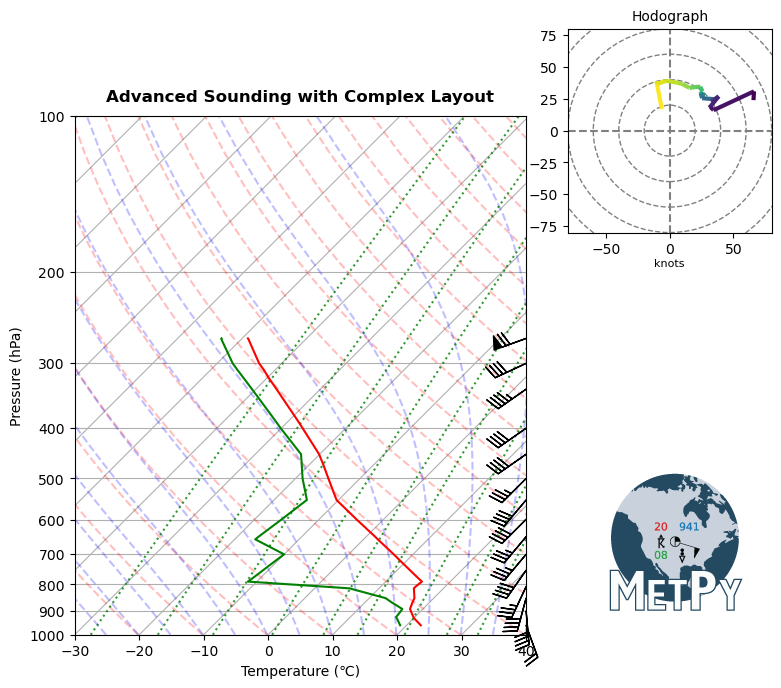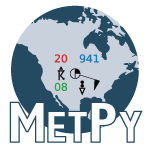Skew-T with Complex Layout
Combine a Skew-T and a hodograph using Matplotlib’s GridSpec layout capability.
Imports
import matplotlib.gridspec as gridspec
import matplotlib.pyplot as plt
import numpy as np
import pandas as pd
import metpy.calc as mpcalc
from metpy.cbook import get_test_data
from metpy.plots import add_metpy_logo, Hodograph, SkewT
from metpy.units import units
Obtain Data and Format
Upper air data can be obtained using the siphon package, but for this example we will use some of MetPy’s sample data.
as_file_obj=False), skiprows=5, usecols=[0, 1, 2, 3, 6, 7], names=col_names) is necessary due to the formatting of the MetPy sample data. This formatting is not needed when using upper air data obtained via Siphon. Obtaining data with Siphon will be covered in a later notebook.
col_names = ['pressure', 'height', 'temperature', 'dewpoint', 'direction', 'speed']
sounding_data = pd.read_fwf(get_test_data('may4_sounding.txt', as_file_obj=False),
skiprows=5, usecols=[0, 1, 2, 3, 6, 7], names=col_names)
# Drop any rows with all not a number (NaN) values for temperature, dewpoint, and winds
sounding_data = sounding_data.dropna(subset=('temperature', 'dewpoint', 'direction', 'speed'
), how='all').reset_index(drop=True)
Assign Units
We will pull the data out of the example dataset into individual variables and assign units. This is explained in further detain in the Simple Sounding notebook and in the Metpy documentation.
pres = sounding_data['pressure'].values * units.hPa
temp = sounding_data['temperature'].values * units.degC
dewpoint = sounding_data['dewpoint'].values * units.degC
wind_speed = sounding_data['speed'].values * units.knots
wind_dir = sounding_data['direction'].values * units.degrees
u, v = mpcalc.wind_components(wind_speed, wind_dir)
Create Sounding Plot
# Create figure and grid for plots
gs = gridspec.GridSpec(ncols=3, nrows=3)
fig = plt.figure(figsize=(9, 9))
skew = SkewT(fig, rotation=45, subplot=gs[:, :2])
# Plot temperature and dewpoint lines
skew.plot(pres, temp, 'red')
skew.plot(pres, dewpoint, 'green')
# Plot wind barbs
my_interval = np.arange(100, 1000, 50) * units('hPa')
ix = mpcalc.resample_nn_1d(pres, my_interval)
skew.plot_barbs(pres[ix], u[ix], v[ix])
# Improve labels and set axis limits
skew.ax.set_xlabel('Temperature (\N{DEGREE CELSIUS})')
skew.ax.set_ylabel('Pressure (hPa)')
skew.ax.set_ylim(1000, 100)
skew.ax.set_xlim(-30, 40)
# Add the relevant special lines
skew.plot_dry_adiabats(t0=np.arange(233, 533, 10) * units.K, alpha=0.25, color='orangered')
skew.plot_moist_adiabats(t0=np.arange(233, 400, 5) * units.K, alpha=0.25, color='tab:green')
skew.plot_mixing_lines(pressure=np.arange(1000, 99, -25) * units.hPa, linestyle='dotted', color='tab:blue')
# Create a hodograph
ax = fig.add_subplot(gs[0, -1])
h = Hodograph(ax, component_range=80)
h.add_grid(increment=20)
h.plot_colormapped(u, v, pres)
ax.text(0.5, -0.15, 'knots', fontsize=8, ha='center', va='center', transform=ax.transAxes) #unit label
# Add the MetPy logo!
fig = plt.gcf()
add_metpy_logo(fig, 600, 70, size='large');
# Add titles
skew.ax.set_title('Advanced Sounding with Complex Layout', fontweight='bold', pad=10)
ax.set_title('Hodograph', fontsize=10);


